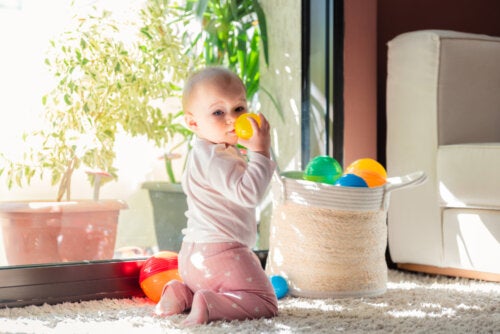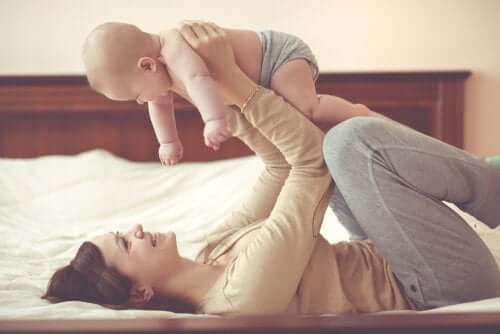The Treasure Basket: A Game for Babies


Written and verified by the pedagogue Marta Crespo Garcia
Between the ages of 6 and 12 months, babies start to sit up on their own and develop their motricity and coordination. Whether at home or at daycare, we can offer little ones a game that allows for free play and exploration. In today’s article, we’ll introduce the concept of the treasure basket.
The treasure basket: A game for babies
English pedagogue Elinor Goldschmied created the idea of the treasure basket for babies between the ages of 6 and 12 months. It consists of a basket full of different objects and materials that allow babies to explore, manipulate, and play freely. This activity boosts sensorial perception as children use their 5 senses to examine the contents of the basket.
The selection of the objects, materials, and gestures that you include in your treasure basket is important. That’s because they’re key in meeting the objective of the game. That is: Stimulating, maximizing, and developing a baby’s senses…
- Touch: shape, weight, temperature, texture, etc.
- Smell and taste: a variety of aromas and flavors
- Hearing: jingling, percussion, friction, crackling, absence of sounds, etc.
- Sight: color, volume, magnitudes, luminosity, brightness, etc.
“Boys and girls don’t play in order to learn, but they learn because they play.”
– Jean Piaget –
Creating your own treasure basket
Making a treasure basket isn’t complicated at all. All you need is a basket and various everyday objects that you have in your home or daycare center.

The basket should be short, preferably whicker and without handles. Inside, you’ll place around 50 to 60 objects that are made of different materials – wood, fabric, yarn, metal, leather, cardboard, paper, even natural objects like fruits, shells, cork, etc…
According to Goldschmied, the creator, you shouldn’t use any plastic objects or toys that came from a store. These items offer hardly any sensory experience and children quickly lose interest in them.
You should also renew the objects in the basket every once in a while, substituting or adding new objects. That way, the experience will be more enriching and little ones won’t lose interest. Of course, you should always be careful regarding the safety and hygiene of every object that goes in.
Below, you’ll find a list of some groups of materials that, according to Goldschmied, you can include in your treasure basket.
- Natural objects: Rocks, shells, pinecones, cork, feathers, apples…
- Objects made of natural materials: Balls of yarn, shoe brushes, make up brushes…
- Wooden objects: Wooden spoon, clothespin, pepper grinder, tambourine…
- Metallic objects: Spoon, keys, harmonica…
- Objects made of leather, fabric, rubber, mesh: Leather coin purse, ball, a scented mesh bag…
- Paper and cardboard objects: book, cardboard tube, glossy paper, photos of familiar objects…
Aspects that benefit from playing with the treasure basket
The treasure basket offers a wide variety of objects and materials for babies to manipulate as they play. Therefore, the activity boosts their development in a variety of ways:
- Motor exercise. Favors both fine and gross psychomotricity. Babies practice fine motor skills as they handle the different objects, and gross motor skills as they move about to reach them.
- Curiosity to explore. Babies choose and carry out different exploration activities, without the intervention of an adult. They manifest their preferences and differences in the way they interact with the objects.
- Stimulation and development of the senses. Babies examine the objects, lick them, turn them around in their hands, bang on them, etc… By doing so, they discover their weight, size, shape, texture, sound, smell, etc.

- The treasure basket boosts distinct coordination skills: Hand-eye, hand-mouth, as well as balance.
- Development of the ability to concentrate. Little ones spend a long time focusing on the activity as they examine, manipulate, lick, bang, and listen to the different objects.
Role of educators and parents
The role of educators and parents when it comes to the treasure box is to assure safety and observe attentively. A glance, a small gesture of affection, a smile… All are enough to initiate contact with the baby and give him or her the security and freedom to enjoy discovering.
While it may seem difficult, adults shouldn’t intervene in the activity. You shouldn’t offer children objects or help them grasp them or reach them. What’s more, according to the creator, you shouldn’t initiate dialogue, as this distracts from the game.
In addition, the preverbal sounds that babies emit during the activity play an important role in the development of language. You should only intervene if you see that your baby could get hurt.
When you see that a baby is tired or losing interest in the game, then you should take the basket away. You shouldn’t set a specific duration for the game – let the child decide how long he or she wants to play.
At the beginning of the article, we clarified that this game is oriented towards children between the ages of 6 and 12 months. However, for children between the ages of 12 and 24 months, we have another very interesting activity. Heuristic play allows older babies to discover and explore freely.
Between the ages of 6 and 12 months, babies start to sit up on their own and develop their motricity and coordination. Whether at home or at daycare, we can offer little ones a game that allows for free play and exploration. In today’s article, we’ll introduce the concept of the treasure basket.
The treasure basket: A game for babies
English pedagogue Elinor Goldschmied created the idea of the treasure basket for babies between the ages of 6 and 12 months. It consists of a basket full of different objects and materials that allow babies to explore, manipulate, and play freely. This activity boosts sensorial perception as children use their 5 senses to examine the contents of the basket.
The selection of the objects, materials, and gestures that you include in your treasure basket is important. That’s because they’re key in meeting the objective of the game. That is: Stimulating, maximizing, and developing a baby’s senses…
- Touch: shape, weight, temperature, texture, etc.
- Smell and taste: a variety of aromas and flavors
- Hearing: jingling, percussion, friction, crackling, absence of sounds, etc.
- Sight: color, volume, magnitudes, luminosity, brightness, etc.
“Boys and girls don’t play in order to learn, but they learn because they play.”
– Jean Piaget –
Creating your own treasure basket
Making a treasure basket isn’t complicated at all. All you need is a basket and various everyday objects that you have in your home or daycare center.

The basket should be short, preferably whicker and without handles. Inside, you’ll place around 50 to 60 objects that are made of different materials – wood, fabric, yarn, metal, leather, cardboard, paper, even natural objects like fruits, shells, cork, etc…
According to Goldschmied, the creator, you shouldn’t use any plastic objects or toys that came from a store. These items offer hardly any sensory experience and children quickly lose interest in them.
You should also renew the objects in the basket every once in a while, substituting or adding new objects. That way, the experience will be more enriching and little ones won’t lose interest. Of course, you should always be careful regarding the safety and hygiene of every object that goes in.
Below, you’ll find a list of some groups of materials that, according to Goldschmied, you can include in your treasure basket.
- Natural objects: Rocks, shells, pinecones, cork, feathers, apples…
- Objects made of natural materials: Balls of yarn, shoe brushes, make up brushes…
- Wooden objects: Wooden spoon, clothespin, pepper grinder, tambourine…
- Metallic objects: Spoon, keys, harmonica…
- Objects made of leather, fabric, rubber, mesh: Leather coin purse, ball, a scented mesh bag…
- Paper and cardboard objects: book, cardboard tube, glossy paper, photos of familiar objects…
Aspects that benefit from playing with the treasure basket
The treasure basket offers a wide variety of objects and materials for babies to manipulate as they play. Therefore, the activity boosts their development in a variety of ways:
- Motor exercise. Favors both fine and gross psychomotricity. Babies practice fine motor skills as they handle the different objects, and gross motor skills as they move about to reach them.
- Curiosity to explore. Babies choose and carry out different exploration activities, without the intervention of an adult. They manifest their preferences and differences in the way they interact with the objects.
- Stimulation and development of the senses. Babies examine the objects, lick them, turn them around in their hands, bang on them, etc… By doing so, they discover their weight, size, shape, texture, sound, smell, etc.

- The treasure basket boosts distinct coordination skills: Hand-eye, hand-mouth, as well as balance.
- Development of the ability to concentrate. Little ones spend a long time focusing on the activity as they examine, manipulate, lick, bang, and listen to the different objects.
Role of educators and parents
The role of educators and parents when it comes to the treasure box is to assure safety and observe attentively. A glance, a small gesture of affection, a smile… All are enough to initiate contact with the baby and give him or her the security and freedom to enjoy discovering.
While it may seem difficult, adults shouldn’t intervene in the activity. You shouldn’t offer children objects or help them grasp them or reach them. What’s more, according to the creator, you shouldn’t initiate dialogue, as this distracts from the game.
In addition, the preverbal sounds that babies emit during the activity play an important role in the development of language. You should only intervene if you see that your baby could get hurt.
When you see that a baby is tired or losing interest in the game, then you should take the basket away. You shouldn’t set a specific duration for the game – let the child decide how long he or she wants to play.
At the beginning of the article, we clarified that this game is oriented towards children between the ages of 6 and 12 months. However, for children between the ages of 12 and 24 months, we have another very interesting activity. Heuristic play allows older babies to discover and explore freely.
All cited sources were thoroughly reviewed by our team to ensure their quality, reliability, currency, and validity. The bibliography of this article was considered reliable and of academic or scientific accuracy.
- MARCO, I. G., & GRACIA, M. P. M. (2020) La utilización de material no estructurado en la Educación Infantil. https://zaguan.unizar.es/record/98012/files/TAZ-TFG-2020-2858.pdf?version=1
- Moyolema, D., & Lcda, A. A. (2022). Caja sensorial para la intervención en el desarrollo motor fino en niños de 1 a 5 años (Master’s thesis, Universdidad Técnica de Ambato/Facultad de Ciencias de la Salud/Centro de posgrados).
- Quispe Peralta, M. (2019). El método Montessori aplicado para los alumnos de educación inicial. http://repositorio.untumbes.edu.pe/bitstream/handle/20.500.12874/1341/QUISPE%20PERALTA%2c%20MARIANA%20%281%29.pdf?sequence=1&isAllowed=y
This text is provided for informational purposes only and does not replace consultation with a professional. If in doubt, consult your specialist.








